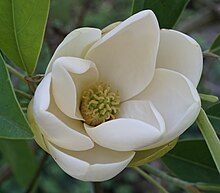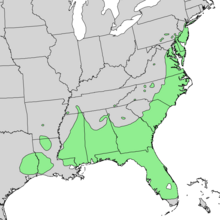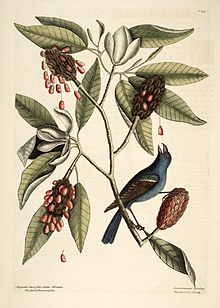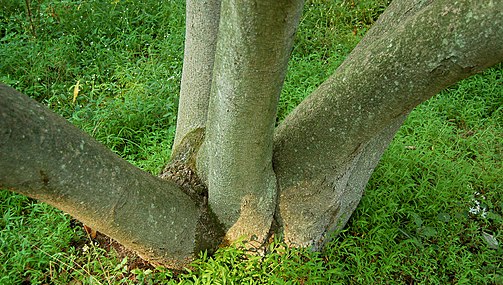
Magnolia is a large genus of about 210 to 340 flowering plant species in the subfamily Magnolioideae of the family Magnoliaceae. The natural range of Magnolia species is disjunct, with a main center in east and southeast Asia and a secondary center in eastern North America, Central America, the West Indies, and some species in South America.
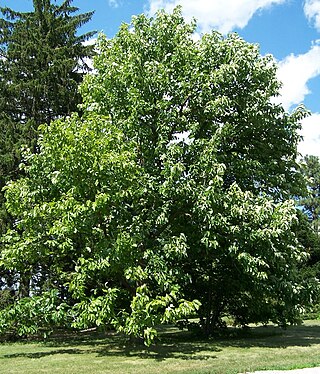
Magnolia acuminata, commonly called the cucumber tree, cucumber magnolia or blue magnolia, is one of the largest magnolias, and one of the cold-hardiest. It is a large forest tree of the Eastern United States and Southern Ontario in Canada. It is a tree that tends to occur singly as scattered specimens, rather than in groves.

Magnolia grandiflora, commonly known as the southern magnolia or bull bay, is a tree of the family Magnoliaceae native to the Southeastern United States, from Virginia to central Florida, and west to East Texas. Reaching 27.5 m (90 ft) in height, it is a large, striking evergreen tree, with large, dark-green leaves up to 20 cm long and 12 cm wide, and large, white, fragrant flowers up to 30 cm (12 in) in diameter.
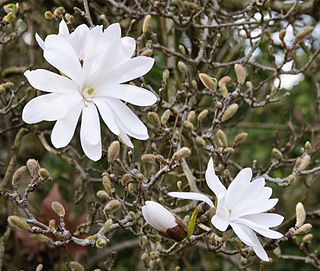
Magnolia stellata, sometimes called the stellaris magnolia, is a slow-growing shrub or small tree native to Japan. It bears large, showy white or pink flowers in early spring, before its leaves open. This species is closely related to the Kobushi magnolia, and is treated by many botanists as a variety or even a cultivar of that. However, Magnolia stellata was accepted as a distinct species in the 1998 monograph by Hunt.
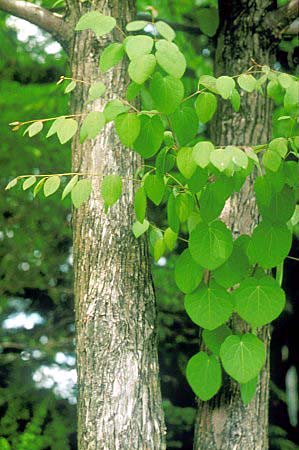
Cercidiphyllum is a genus containing two species of plants, both commonly called katsura. They are the sole members of the monotypic family Cercidiphyllaceae. The genus is native to Japan and China and unrelated to Cercis (redbuds).

Magnolia tripetala, commonly called umbrella magnolia or simply umbrella-tree, is a deciduous tree native to the eastern United States in the Appalachian Mountains, the Ozarks, and the Ouachita Mountains. The name "umbrella tree" derives from the fact that the large leaves are clustered at the tips of the branches forming an umbrella-shaped structure.

Magnolia fraseri, commonly known as Fraser magnolia, mountain magnolia, earleaf cucumbertree, or mountain-oread, is a species of magnolia native to the south-eastern United States in the southern Appalachian Mountains and adjacent Atlantic and Gulf Coastal Plain from West Virginia south to northern Florida and west to eastern Texas. The Appalachian plants are classified as Magnolia fraseri var. fraseri, and the more coastal plants as M. fraseri var. pyramidata. These two kinds of magnolia are often recognized as distinct species, M. fraseri and M. pyramidata, respectively.

Magnolia macrophylla, the bigleaf magnolia, is a deciduous magnolia native to the southeastern United States and eastern Mexico. This species boasts the largest simple leaf and single flower of any native plant in North America.

Pseudolarix amabilis is a species of coniferous tree in the pine family Pinaceae. The species is commonly known as golden larch, but being more closely related to Keteleeria, Abies and Cedrus, is not a true larch (Larix). P. amabilis is native to eastern China, occurring in small areas in the mountains of southern Anhui, Zhejiang, Fujian, Jiangxi, Hunan, Hubei and eastern Sichuan, at altitudes of 100–1,500 m (328–4,921 ft). The earliest known occurrences are of compression fossils found in the Ypresian Allenby Formation and mummified fossils found in the Late Eocene Buchanan Lake Formation on Axel Heiberg Island.

Magnolia sieboldii, or Siebold's magnolia, also known as Korean mountain magnolia and Oyama magnolia, is a species of Magnolia native to east Asia in China, Japan, and Korea. It is named after the German doctor Philipp Franz von Siebold (1796–1866).

Magnolia officinalis is a species of Magnolia native to the mountains and valleys of China at altitudes of 300–1500 m.

Magnolia salicifolia, also known as willow-leafed magnolia or anise magnolia, originates from Japan. It is a small deciduous tree 7.5 m (25 ft) tall, with narrow lanceolate leaves with whitened undersides. The leaves are not as narrow as true willows (Salix), but is narrow compared to other magnolias, giving this tree a finer texture. The 10 cm-wide scented flowers emerge in early spring before the leaves. Flowers have six petals. The leaves and bark are fragrant when crushed. It grows in rocky, granite soil along stream banks.
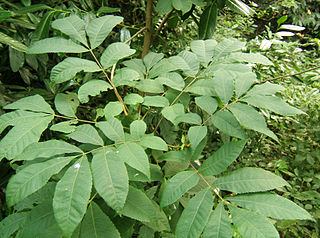
Carya cordiformis, the bitternut hickory, also called bitternut, yellowbud hickory, or swamp hickory, is a large pecan hickory with commercial stands located mostly north of the other pecan hickories. Bitternut hickory is cut and sold in mixture with the true hickories. It is the shortest-lived of the hickories, living to about 200 years.
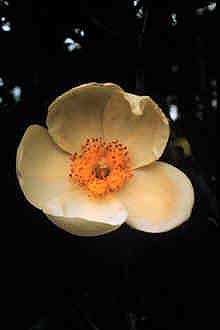
Gordonia lasianthus is a small to medium-sized evergreen tree or shrub found in acidic, swampy soils of pinelands and bays on the Atlantic and Gulf Coastal Plains of the southeastern United States. It is a member of the tea or family Theaceae. It is slow growing with soft, light-colored, fine-grained wood of little commercial value, although loblolly-bay could be managed as a source of pulpwood. When older specimens are cut, the wood exudes a strong scent. It is similar to a mixture of fresh oranges and pine sap. The bark of the adult tree varies from medium grey to a red brown coloration. Dead adult specimens of loblolly bay exhibit a lustrous shine when exposed to sunlight for several years. The white showy flowers and shiny foliage make it a desirable ornamental, but it is not easy to cultivate. Deer browse stump sprouts heavily.

Magnolia sprengeri, or Sprenger's magnolia, is a species of Magnolia native to China, occurring in Gansu, Henan, Hubei, Hunan, Shaanxi, and Sichuan in forests or thickets at 1300–2400 m altitude. Named for Carl Ludwig Sprenger, a botanist of note.

Magnolia kobus, known as mokryeon, kobus magnolia, or kobushi magnolia, is a species of Magnolia native to Japan and Korea and occasionally cultivated in temperate areas. It is a deciduous, small to tall tree which has a slow rate of growth but can reach 8–15 m (25–50 ft) in height and up to 10 m (35 ft) in spread.

Heptacodium miconioides, the seven-son flower, is a species of flowering plant. It is the sole species in the monotypic genus Heptacodium, of the honeysuckle family Caprifoliaceae. The common name "seven-son flower" is a direct translation of the Standard Chinese name 七子花 qī zi huā.

Illicium parviflorum, commonly known as yellow anisetree, yellow-anise, swamp star-anise, and small anise tree, is a species of flowering plant in the family Schisandraceae, or alternately, the Illiciaceae. It is native to Florida in the United States. It historically occurred in Georgia as well, but it has been extirpated from the state.

Cercidiphyllum japonicum, known as the katsura, is a species of flowering tree in the family Cercidiphyllaceae native to China and Japan. It is sometimes called caramel tree for the light caramel smell it emits during leaf fall.

Magnolia × thompsoniana is a hybrid plant in the genus Magnolia and family Magnoliaceae. It is a semideciduous tree with large white fragrant flowers.
